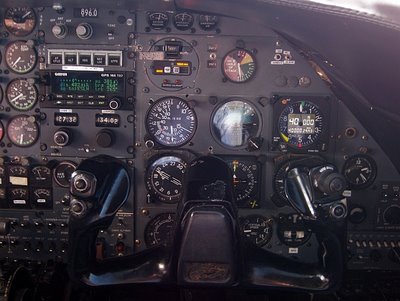Wasting $$
This week on the road I've gotten the chance to take some more pictures of interesting stuff I've seen while flying. I got to ride in a De-Icing truck bucket for the first time. Saw my first flying Eclipse Jet outside of EAA Oshkosh and heard some funny stories from the Captain I'm flying with. The best story of the week was about how a company loves to save money, yet wastes money in the pursuit of cost savings. So here goes.
A pilot at a company (that shall remain nameless) was having a meeting with the CP (Chief Pilot). Somehow they got on the topic of how the company tries to save money. The CP had a little demonstration to show the pilot how the company likes to go about saving money. He pulls out a quarter and a $100 bill from his pocket. He tosses the quarter of the floor and puts the $100 bill in front of the quarter. The CP then takes his foot and stomps on the $100 bill while reaching over to pick up the quarter. I nearly fell out of my seat because I was laughing so hard when I heard that. It is so true. Case in point, this week we were airlined to a plane that had been previously grounded for mechanical reasons. The company sent a mechanic that supposedly fixed everything. The company sold a trip on the aircraft before checking with the mechanics to see if everything had been fixed. We get to the plane and while looking over the paperwork for the maintenance that had been done, we notice that an MEL'd item had expired and had not been fixed. Long story short, trip cancelled, plane still grounded, waste of a lot of money to airline us to a broken plane. Definitely not the first time this has happened.

Here is the Eclipse Jet that I saw. Apparently this was the first time the controller had seen one as well because he asked the pilot what type of aircraft it was.

We got a kick out of seeing this parked in front of a Museum. That is exactly where that hunk of flying junk belongs.
A pilot at a company (that shall remain nameless) was having a meeting with the CP (Chief Pilot). Somehow they got on the topic of how the company tries to save money. The CP had a little demonstration to show the pilot how the company likes to go about saving money. He pulls out a quarter and a $100 bill from his pocket. He tosses the quarter of the floor and puts the $100 bill in front of the quarter. The CP then takes his foot and stomps on the $100 bill while reaching over to pick up the quarter. I nearly fell out of my seat because I was laughing so hard when I heard that. It is so true. Case in point, this week we were airlined to a plane that had been previously grounded for mechanical reasons. The company sent a mechanic that supposedly fixed everything. The company sold a trip on the aircraft before checking with the mechanics to see if everything had been fixed. We get to the plane and while looking over the paperwork for the maintenance that had been done, we notice that an MEL'd item had expired and had not been fixed. Long story short, trip cancelled, plane still grounded, waste of a lot of money to airline us to a broken plane. Definitely not the first time this has happened.

Here is the Eclipse Jet that I saw. Apparently this was the first time the controller had seen one as well because he asked the pilot what type of aircraft it was.

We got a kick out of seeing this parked in front of a Museum. That is exactly where that hunk of flying junk belongs.









